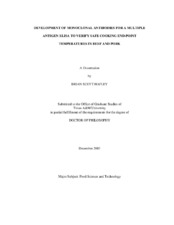| dc.description.abstract | Four proteins exhibiting different rates of denaturation or precipitation with
increasing cooking temperature from 63 to 73°C for beef and 67 to 79°C for pork were
selected for developing a ratio model and incorporating the results into a mathematical
expression. Monoclonal antibodies (Mabs) against lactate dehydrogenase isozyme 5
(LDH-5), bovine serum albumin (BSA), porcine enolase, and bovine myoglobin were
developed for use in a sandwich enzyme-linked immunosorbent assay (ELISA) to
simultaneously investigate changes in protein concentration with incremental increases
in temperature.
Four groups of mice were immunized separately with commercially available or
purified protein (LDH-5, BSA, enolase, or myoglobin). After reporting ample blood
serum titers, spleen cells were harvested and fused with SP2 myeloma tumor cells using
an electro fusion cell manipulator. Hybridoma containing wells were screened against
their respective protein to isolate hybridomas secreting protein specific Mabs. Tissue culture flask produced Mabs were used initially in sandwich ELISA assay
testing. Mabs were tested against ground beef and pork cooked to instantaneous endpoint
temperatures (EPTs). A 6 g section removed from the geometric center of each
sample was homogenized in phosphate buffer, centrifuged, and a 1 ml aliquot collected
for analysis.
Microtiter plates were coated with goat anti-mouse IgG antibody (2 mg/ml) to act
as a capture antibody for the protein specific monoclonal antibody concentrated from cell
culture supernatant. Serial diluted muscle (beef or pork) extract (10 ml) from each EPT
was applied to a microtiter plate. A protein A/G purified polyclonal antibody (Pab) was
applied, followed by a goat anti-rabbit IgG peroxidase conjugated antibody.
Concentration was determined by comparison to a standard curve.
After multiple cell fusions, 24, 29, 66, and 12 cell lines secreting protein specific
Mabs against LDH-5, BSA, enolase, and myoglobin, respectively, were produced. Six
Mabs against LDH-5 reported R2 values > 0.9 indicating high specificity and affinity for
LDH-5. Sandwich ELISA assays development with Mabs against BSA, enolase, and
myoglobin was not as successful. Mouse ascites produced Mabs against BSA, enolase,
and myoglobin were also unsuccessful when used in a sandwich ELISA. However,
preliminary data suggested a multiple antigen ratio model still remained a viable option. | en |


